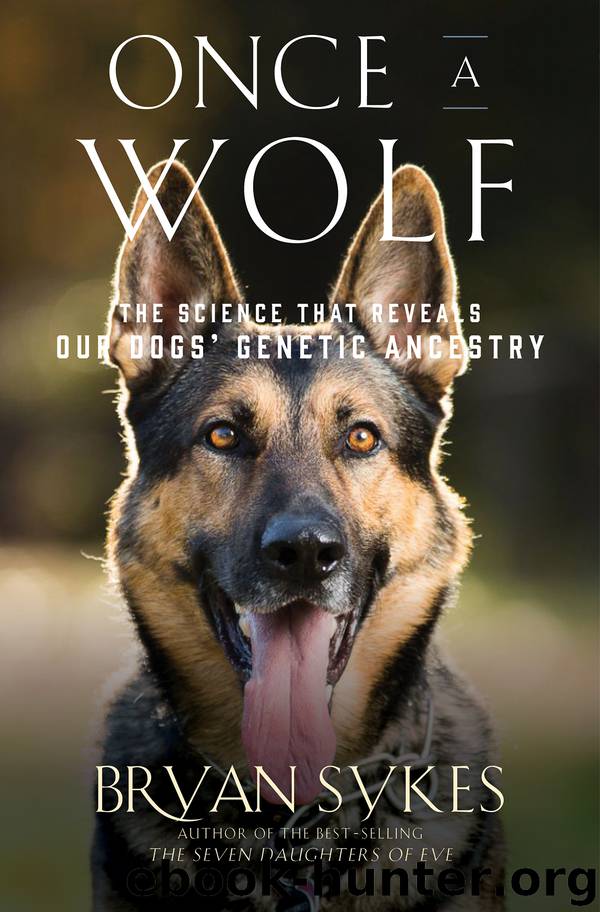Once a Wolf: The Science Behind Our Dogs' Astonishing Genetic Evolution by Bryan Sykes

Author:Bryan Sykes
Language: eng
Format: epub
Publisher: Liveright
Published: 2019-03-26T00:00:00+00:00
So far we have only considered genetic traits in the dog that affect its physical aspects – size, coat-colour, musculature and so on. These have a rich variety of causes involving a range of different mutation types in a large number of genes. The genetic complexity of these changes, great as they are, have been solved thanks to our recently acquired detailed knowledge of the dog genome. Through this, researchers have identified candidate genes which, given a bit of luck, have often turned up trumps and have been shown to be the location of causal mutations. However, the creation of a set of equally spaced genetic markers covering the entire genome has led to the ability to locate genes when inspired guesswork fails. These saturation mapping techniques make no assumptions about the nature of the genes involved and just plough through the genome until their locations are revealed.
Once those are mapped, like an X marked on a treasure chart, detailed sequencing around the location soon reveals the gene itself and usually the exact mutation behind the trait. The modern structure of pedigree breeds, which have become increasingly closed genetic systems, helps a great deal in these gene mapping enterprises, although, as we have seen, the accompanying genetic isolation promotes inbreeding and the appearance of often damaging recessive traits. All the recent successes depend not only on the extravagant technology but also on a basic requirement of the genetics. To map a gene you need a feature which varies within the breed and which is relatively straightforward to score. For example, the experiments with coat-colour mapped the melanism gene because it was easy to tell which dogs were black and which were not. The trait is said to ‘segregate’ within the breed. If a trait does not segregate and all dogs are the same, then the genes responsible cannot be mapped however many markers are used. Candidate genes can still be scrutinised for obviously disabling mutations like frameshift deletions, but, as we have seen, this is very much a hit-or-miss affair.
The great successes over the last decade or so since the dog genome was published in 2005 have been in identifying genes responsible for physical genetic traits like coat-colour or inherited disorders. Of at least equal and perhaps greater interest is the genetics which lies behind differences not in appearance but in behaviour. These might be between breeds or between different individuals within the same breed. For example, a bloodhound makes a good hunting dog but is hopeless at herding sheep. Equally an Old English Sheepdog will control a flock of sheep with ease but would be next to useless following a scent through thick undergrowth. These differences between breeds have been known for millennia and indeed have been under intense selection for almost as long as dogs have been our companions. They have a genetic basis, but it has proved extraordinarily difficult to identify the genes involved, for a number of reasons.
First of all, whether or not the trait segregates is an essential requirement for mapping.
Download
This site does not store any files on its server. We only index and link to content provided by other sites. Please contact the content providers to delete copyright contents if any and email us, we'll remove relevant links or contents immediately.
| Amphibians | Animal Behavior & Communication |
| Animal Psychology | Ichthyology |
| Invertebrates | Mammals |
| Ornithology | Primatology |
| Reptiles |
Sapiens: A Brief History of Humankind by Yuval Noah Harari(14319)
The Tidewater Tales by John Barth(12625)
Mastermind: How to Think Like Sherlock Holmes by Maria Konnikova(7278)
Do No Harm Stories of Life, Death and Brain Surgery by Henry Marsh(6905)
The Thirst by Nesbo Jo(6877)
Why We Sleep: Unlocking the Power of Sleep and Dreams by Matthew Walker(6655)
Life 3.0: Being Human in the Age of Artificial Intelligence by Tegmark Max(5514)
Sapiens by Yuval Noah Harari(5322)
The Longevity Diet by Valter Longo(5040)
The Body: A Guide for Occupants by Bill Bryson(5027)
The Rules Do Not Apply by Ariel Levy(4910)
The Immortal Life of Henrietta Lacks by Rebecca Skloot(4550)
Animal Frequency by Melissa Alvarez(4427)
Why We Sleep by Matthew Walker(4394)
The Hacking of the American Mind by Robert H. Lustig(4338)
Yoga Anatomy by Kaminoff Leslie(4332)
All Creatures Great and Small by James Herriot(4269)
Double Down (Diary of a Wimpy Kid Book 11) by Jeff Kinney(4240)
Embedded Programming with Modern C++ Cookbook by Igor Viarheichyk(4141)
